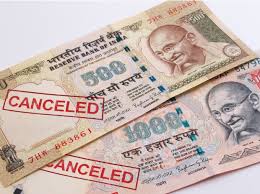
By K Singhania & Co | November 29, 2016
Published in
DEMONETISATION – Emergence of New India
On 8th November 2016, Prime Minister Narendra Modi announced that all currency notes in denominations of Rs. 500 and Rs. 1000 would be rendered illegal in the country with effect from midnight. The move proved to be a surprise as citizens had only 4 hours to react to the PM’s statement. In his televised address to the nation, PM Modi said that people holding notes of Rs. 500 and Rs. 1000 can deposit it in their bank and post office accounts from 10th November till 30th December 2016.
When 86% of currency notes in a country of 1.3 billion people are rendered illegal in a matter of hours, it is bound to create short-term disruptions in daily lives. This bold move had taken the nation by surprise, creating chaos.
While the intellectual cream of the society support this sudden move by the government to strike at black money laundering in the country, the poor fail to understand the drama.
The rationale behind this radical financial step of declaring the currency unit invalid is two-fold. Firstly, the estimated total value of fake currency in circulation in India is detected to be Rs. 14.3 lakh crore. The intelligence agency feels that there is a printing press across the borders for nefarious activities. Hence this decision is taken to lower the cash circulation in the country which “is directly related to corruption in our country,” according to PM Modi.
Secondly, it is done to widen the tax base and disclose the black money. Presently there are only 2.5 crore tax payers in the country that includes people with nil income. Thus making the tax to GDP percentage as low as 10.6%, equivalent to that of Africa. As a result of which, the political parties use this unaccounted money for election funding.
The Centre’s Black Money (Undisclosed Foreign Income and Assets) and Imposition of Tax Act, 2015 came as a big disappointment raking in only about Rs. 2,400 crores in taxes. The latest Income Declaration Scheme (IDS) too grossly fell short of expectations adding to about Rs. 30,000 crores to the Centre’s kitty.
But after this brave step by the government, around Rs. 1.5 lakh crores in deposits were collected by banks within two days of the announcement. Those with no bank accounts would now be forced to open one in order to deposit the now-illegal notes, in turn helping PM Modi’s Pradhan Mantri Jan Dhan Yojana. India’s internet startups are cashing in on the opportunity, too. Within 15 hours of PM Modi’s announcement, Ola saw an increase of 15 times in recharge volumes on its e-wallet. Paytm too has had a 300% surge in transactions at offline retail stores within 10 days.
In this day and age disruptive technologies and events are considered to be good. Likewise demonetization has come as a shock and caused a lot of disruption. Although demonetization has been done many times in the past, without it disrupting the lives of ordinary Indians, this time it is alleged to be in the contrary. Some blame on lack of adequate planning and the others on the necessity of secrecy.
The largest adversely affected group is the working class that adds up to about 400 million persons. Their incomes are the lowest and least secure. Those paid in old Rs. 500 or Rs. 1000 notes would have had to lose a day’s wage to queue up at banks to convert their money. In the towns and cities, these workers are queuing up at banks. And at unbanked villages, the government has reportedly dispatched armies of mobile-banking correspondents to service such villages. The regular organized sector workers, the most skilled and the best paid would have received their wages shortly before the demonetization. Without conversion, none of them would have usable money for food, medical expenses and other essentials. However theirs is only a temporary inconvenience or what the PM says, “50 days of hardship.”
The real target of demonetization is the big fish who have amassed huge wealth from black money and hold most of it as real estate, gold and other real assets in India and abroad. A relatively small portion is held as non-bank money to finance ‘black’ transactions. The real estate industry is the destination where large proportion of black money flows and is converted into real assets. The approach for India is to adopt the Torrens system wherein land ownership is directly registered by the State. Clear government guaranteed titles will curb fraudulent realty deals. Therefore the government will crack down on benami properties.
Benami properties are registered in the name of third parties, fictitious or otherwise, by the owner who remains anonymous, making these properties instruments to generate and hide wealth. Now that an amended law known as the Benami Transactions (Prohibition) Amendment Act, 2016 is in force, the government wants to act to step up its campaign against black money.
Apart from the daily complaints of the people, there’s much talk on the role played by the Central Bank as well. Officials pointed out that RBI Governor Urjit Patel should have provided realistic assessments on how this plan should be carried out, especially since it has all the data it needs regarding the rural and urban distribution of banks and ATMs and the printing capacity at mints around the country.
Questions are also being asked as to why only Economic Affairs Secretary Shaktikanta Das has been given the responsibility of interacting with the media, and through it to the larger public. And why has not much been heard from other senior planners, including Finance Secretary Ashok Lavasa, Financial Services Secretary Anjuly Chib Duggal and indeed RBI Governor Patel.
In spite of all the criticisms, this step had to be taken suddenly without warning, for the purpose to be fulfilled. When PM Narendra Modi says “I promise you I will give you the India which you desired” one would have to be small-minded to complain about 50 days of hardship.
Subscribe to our Newsletter
Sign up for daily, weekly, monthly newsletter to get the latest news updates delivered directly to your inbox.
Recent Posts
-

Protecting Brands In India And Europe: Comparison Of Trademarks Laws
February 21, 2024



Leave a Reply